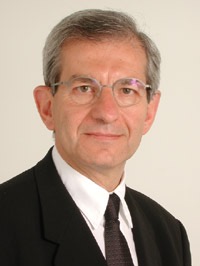Enrico Deaglio (born 11 April 1947) is an Italian journalist, writer and TV presenter.
Enrico Deaglio (born 11 April 1947) is an Italian journalist, writer and TV presenter.
Deaglio was born in Turin, where he graduated in medicine (June 1971) and worked in the Mauriziano Hospital.
In the mid-1970s, he started his journalist career for the communist newspaper Lotta continua , of which he was editor from 1977 to 1982. Later he worked for numerous national newspapers and magazine, including La Stampa , Il Manifesto , Panorama , Epoca and l'Unità . From 1985 to 1986 he was the editor of the newspaper Reporter.
From the later 1980s he worked for the news show Mixer on RAI TV, focusing in particular on the Sicilian mafia and events Abroad. In the 1990s he hosted several shows on Rai Tre, such as Milano, Italia (January–June 1994), Ragazzi del '99 (1999), Così va il mondo, Vento del Nord and L'Elmo di Scipio. From 1997 to 2008 he was editor of the weekly Diario.
In 2006 his TV documentary Uccidete la democrazia! (Kill Democracy!), where he suggested that electronic votes in the 2006 Italian general elections were manipulated in favour of Silvio Berlusconi's party, House of Freedoms, generated significant controversies. Deaglio's theory was subsequently discarded by an official recount of ballots by the Italian Parliament. [1]
His brother, Mario Deaglio, is an economist at the University of Turin.

La Stampa is an Italian daily newspaper published in Turin, Italy. It is distributed in Italy and other European nations. It is one of the oldest newspapers in Italy.

Marco Travaglio is an Italian investigative journalist, writer and opinion leader, editor of the independent journal Il Fatto Quotidiano.

Luciano Violante is an Italian judge and politician, Member of Parliament from 1979 to 2008. He is particularly interested in questions of justice, the struggle against the Mafia and institutional reform.
Franco Lucentini was an Italian writer, journalist, translator and editor of anthologies.

Carlo Fruttero was an Italian writer, journalist, translator and editor of anthologies.
Nico Perrone is an Italian essayist, historian and journalist. He firstly discovered papers on the plot for killing Enrico Mattei, the Italian state tycoon for oil in the 1950s.

Corrado Alvaro was an Italian journalist and writer of novels, short stories, screenplays and plays. He often used the verismo style to describe the hopeless poverty in his native Calabria. His first success was Gente in Aspromonte, which examined the exploitation of rural peasants by greedy landowners in Calabria, and is considered by many critics to be his masterpiece.

Arrigo Levi was an Italian journalist, essayist, and television anchorman.

Bruno Paolo Vespa is an Italian television and newspaper journalist.
Luciano del Castillo is an Italian photographer and journalist specializing in war photography.

Arrigo Petacco was an Italian writer, historian and journalist.

Sergio Romano is an Italian diplomat, writer, journalist, and historian. He is a columnist for the newspaper Corriere della Sera. Romano is also a former Italian ambassador to Moscow.

L'Ora was a Sicilian daily newspaper published in Palermo. The paper was founded in 1900 and stopped being published in 1992. In the 1950s-1980s the paper was known for its investigative reporting about the Sicilian Mafia.
This is a list of Italian television related events from 2001.

Giovanni Spampinato was an Italian investigative journalist for the Italian newspaper L'Ora in Ragusa, Province of Ragusa, Sicily, Italy, who brought to attention mafiaso Roberto Campria's connection to a murder in February 1972, before his own murder eight months later.
Carlo Casalegno was an Italian journalist and writer. He was killed by a group of four terrorists belonging to the Red Brigades; he was the first journalist ever to be killed during the Years of lead.
Adele Cambria was an Italian journalist, writer, and actress.
Vittorio Gorresio was an Italian Journalist-commentator and essayist.

Giampaolo Pansa was an Italian journalist-commentator and, especially during his later years, a prolific author of books and essays. Much of his writing was rooted in recent or contemporary history, notably with regard to the antifascist resistance of the Mussolini years.

Giorgio Forattini is an Italian drawer, cartoonist and journalist. Since 1973 his cartoons have been published on the chief Italian newspapers. Forattini comments "with a corrosive and irreverent humor, the events of Italian and international political life." His cartoons have been published in many collections, including Referendum reverendum (1974), Quattro anni di storia italiana (1977), Nudi alla meta (1985), Insciaquà (1990), Bossic Instinct (1993), Il libro a colori del post-comunismo (1998), Foratt pride (2000), Oltre la Fifa (2002), Il Signore degli Agnelli (2004), Regimen (2006), Vaffancolor (2007), Revoluscon (2008), Satiromantico (2009), Siamo uomini o giornalisti? (2010), Eurodeliri (2011), Fateci la carità (2012), Napoleonitano (2013), Arieccoci (2016), Abbecedario della politica (2017).